Analysis of Management Accounting Principles, Tools, and Adaptation
VerifiedAdded on 2023/06/11
|9
|2594
|96
Report
AI Summary
This report delves into the principles of management accounting, highlighting techniques and methods used for reporting, such as margin analysis, capital budgeting, trend analysis, inventory valuation, and constraint analysis. It also discusses the advantages and disadvantages of various budgetary tools like activity-based budgeting, zero-based budgeting, and cash budgets. Furthermore, the report examines how organizations, specifically Sainsbury and Marks & Spencer, adapt their management systems to address financial problems like poor budgeting and cash flow crises by implementing strategies such as cash budgeting and benchmarking tools. The analysis concludes that management accounting is crucial for improving organizational efficiencies and managing operations effectively.
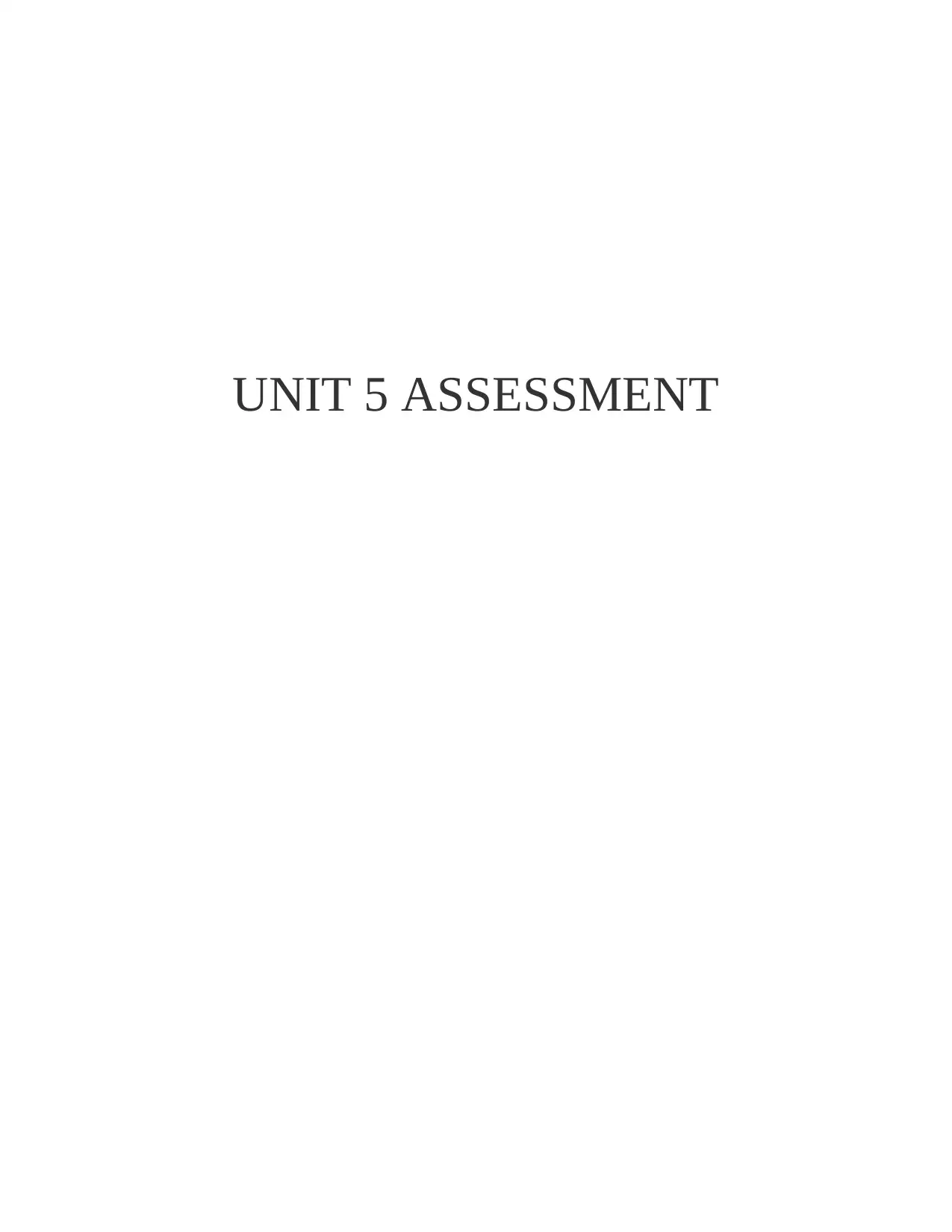
UNIT 5 ASSESSMENT
Paraphrase This Document
Need a fresh take? Get an instant paraphrase of this document with our AI Paraphraser
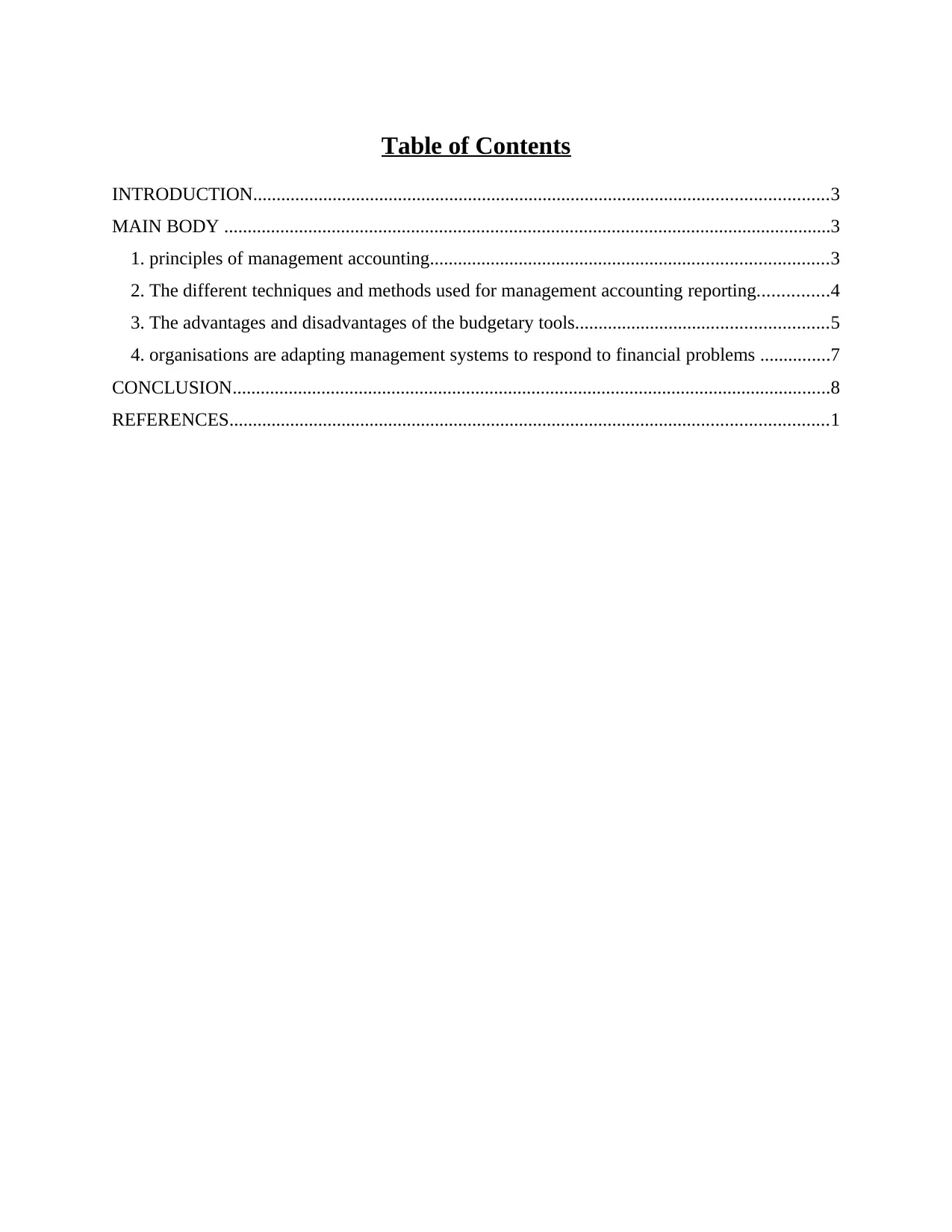
Table of Contents
INTRODUCTION...........................................................................................................................3
MAIN BODY ..................................................................................................................................3
1. principles of management accounting.....................................................................................3
2. The different techniques and methods used for management accounting reporting...............4
3. The advantages and disadvantages of the budgetary tools......................................................5
4. organisations are adapting management systems to respond to financial problems ...............7
CONCLUSION................................................................................................................................8
REFERENCES................................................................................................................................1
INTRODUCTION...........................................................................................................................3
MAIN BODY ..................................................................................................................................3
1. principles of management accounting.....................................................................................3
2. The different techniques and methods used for management accounting reporting...............4
3. The advantages and disadvantages of the budgetary tools......................................................5
4. organisations are adapting management systems to respond to financial problems ...............7
CONCLUSION................................................................................................................................8
REFERENCES................................................................................................................................1
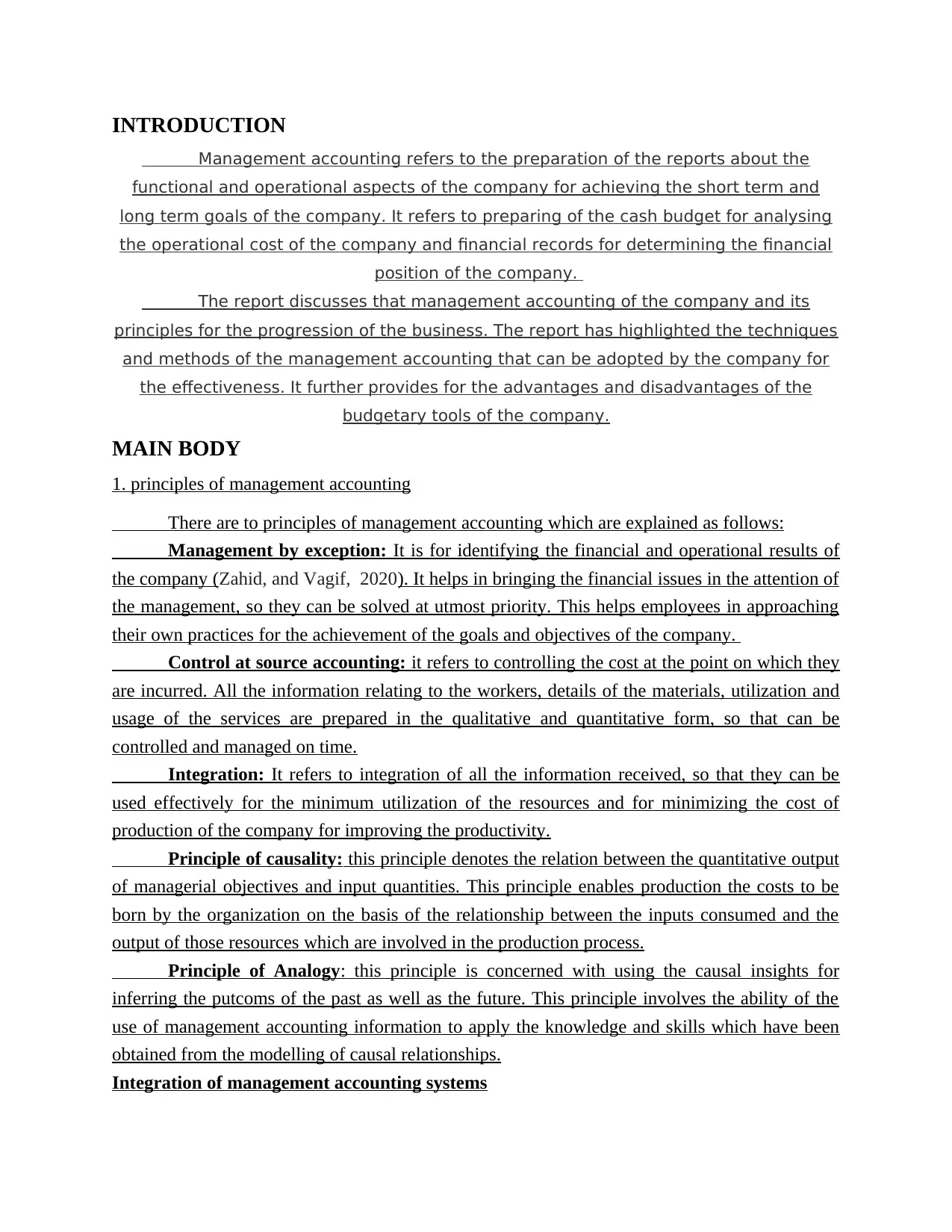
INTRODUCTION
Management accounting refers to the preparation of the reports about the
functional and operational aspects of the company for achieving the short term and
long term goals of the company. It refers to preparing of the cash budget for analysing
the operational cost of the company and financial records for determining the financial
position of the company.
The report discusses that management accounting of the company and its
principles for the progression of the business. The report has highlighted the techniques
and methods of the management accounting that can be adopted by the company for
the effectiveness. It further provides for the advantages and disadvantages of the
budgetary tools of the company.
MAIN BODY
1. principles of management accounting
There are to principles of management accounting which are explained as follows:
Management by exception: It is for identifying the financial and operational results of
the company (Zahid, and Vagif, 2020). It helps in bringing the financial issues in the attention of
the management, so they can be solved at utmost priority. This helps employees in approaching
their own practices for the achievement of the goals and objectives of the company.
Control at source accounting: it refers to controlling the cost at the point on which they
are incurred. All the information relating to the workers, details of the materials, utilization and
usage of the services are prepared in the qualitative and quantitative form, so that can be
controlled and managed on time.
Integration: It refers to integration of all the information received, so that they can be
used effectively for the minimum utilization of the resources and for minimizing the cost of
production of the company for improving the productivity.
Principle of causality: this principle denotes the relation between the quantitative output
of managerial objectives and input quantities. This principle enables production the costs to be
born by the organization on the basis of the relationship between the inputs consumed and the
output of those resources which are involved in the production process.
Principle of Analogy: this principle is concerned with using the causal insights for
inferring the putcoms of the past as well as the future. This principle involves the ability of the
use of management accounting information to apply the knowledge and skills which have been
obtained from the modelling of causal relationships.
Integration of management accounting systems
Management accounting refers to the preparation of the reports about the
functional and operational aspects of the company for achieving the short term and
long term goals of the company. It refers to preparing of the cash budget for analysing
the operational cost of the company and financial records for determining the financial
position of the company.
The report discusses that management accounting of the company and its
principles for the progression of the business. The report has highlighted the techniques
and methods of the management accounting that can be adopted by the company for
the effectiveness. It further provides for the advantages and disadvantages of the
budgetary tools of the company.
MAIN BODY
1. principles of management accounting
There are to principles of management accounting which are explained as follows:
Management by exception: It is for identifying the financial and operational results of
the company (Zahid, and Vagif, 2020). It helps in bringing the financial issues in the attention of
the management, so they can be solved at utmost priority. This helps employees in approaching
their own practices for the achievement of the goals and objectives of the company.
Control at source accounting: it refers to controlling the cost at the point on which they
are incurred. All the information relating to the workers, details of the materials, utilization and
usage of the services are prepared in the qualitative and quantitative form, so that can be
controlled and managed on time.
Integration: It refers to integration of all the information received, so that they can be
used effectively for the minimum utilization of the resources and for minimizing the cost of
production of the company for improving the productivity.
Principle of causality: this principle denotes the relation between the quantitative output
of managerial objectives and input quantities. This principle enables production the costs to be
born by the organization on the basis of the relationship between the inputs consumed and the
output of those resources which are involved in the production process.
Principle of Analogy: this principle is concerned with using the causal insights for
inferring the putcoms of the past as well as the future. This principle involves the ability of the
use of management accounting information to apply the knowledge and skills which have been
obtained from the modelling of causal relationships.
Integration of management accounting systems
⊘ This is a preview!⊘
Do you want full access?
Subscribe today to unlock all pages.

Trusted by 1+ million students worldwide
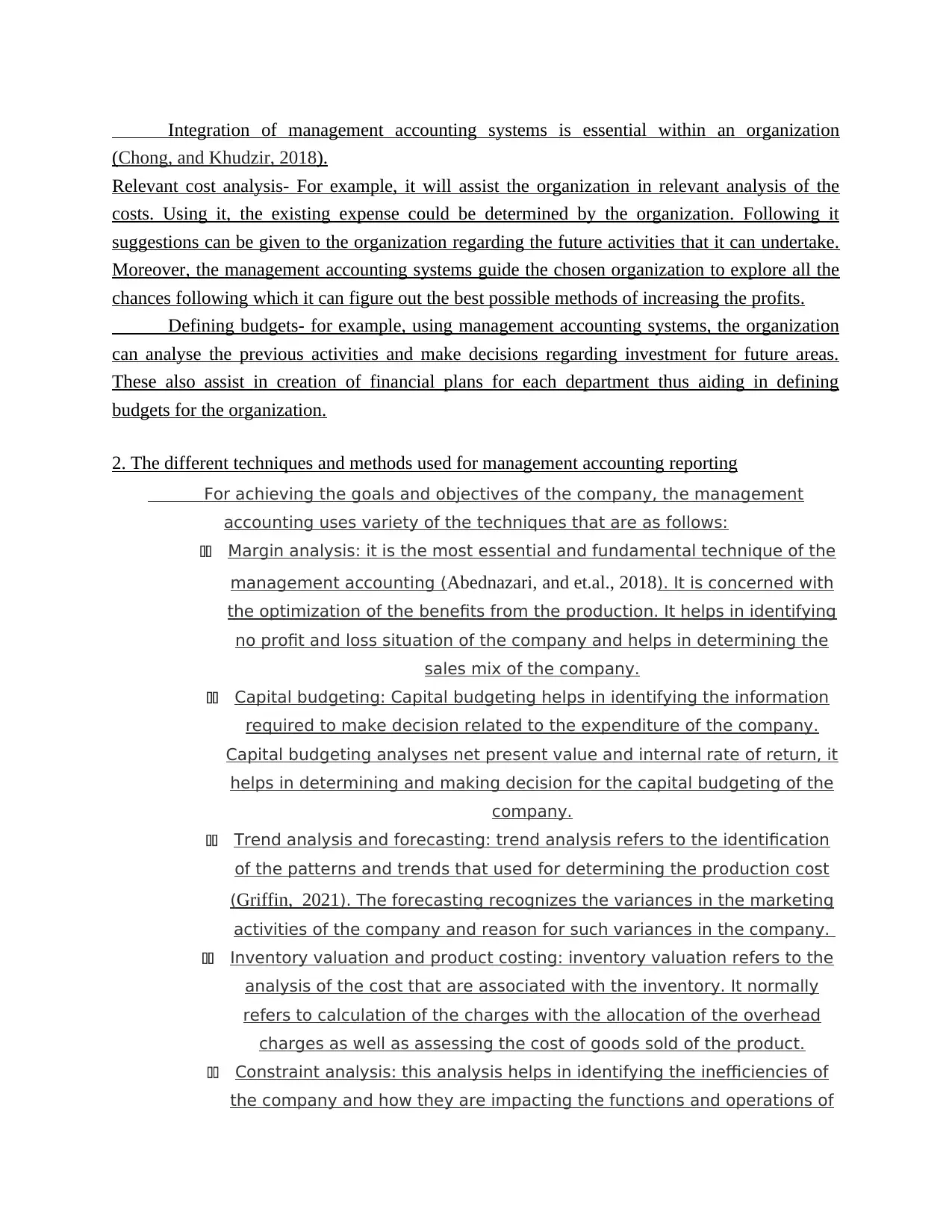
Integration of management accounting systems is essential within an organization
(Chong, and Khudzir, 2018).
Relevant cost analysis- For example, it will assist the organization in relevant analysis of the
costs. Using it, the existing expense could be determined by the organization. Following it
suggestions can be given to the organization regarding the future activities that it can undertake.
Moreover, the management accounting systems guide the chosen organization to explore all the
chances following which it can figure out the best possible methods of increasing the profits.
Defining budgets- for example, using management accounting systems, the organization
can analyse the previous activities and make decisions regarding investment for future areas.
These also assist in creation of financial plans for each department thus aiding in defining
budgets for the organization.
2. The different techniques and methods used for management accounting reporting
For achieving the goals and objectives of the company, the management
accounting uses variety of the techniques that are as follows:
11 Margin analysis: it is the most essential and fundamental technique of the
management accounting (Abednazari, and et.al., 2018). It is concerned with
the optimization of the benefits from the production. It helps in identifying
no profit and loss situation of the company and helps in determining the
sales mix of the company.
11 Capital budgeting: Capital budgeting helps in identifying the information
required to make decision related to the expenditure of the company.
Capital budgeting analyses net present value and internal rate of return, it
helps in determining and making decision for the capital budgeting of the
company.
11 Trend analysis and forecasting: trend analysis refers to the identification
of the patterns and trends that used for determining the production cost
(Griffin, 2021). The forecasting recognizes the variances in the marketing
activities of the company and reason for such variances in the company.
11 Inventory valuation and product costing: inventory valuation refers to the
analysis of the cost that are associated with the inventory. It normally
refers to calculation of the charges with the allocation of the overhead
charges as well as assessing the cost of goods sold of the product.
11 Constraint analysis: this analysis helps in identifying the inefficiencies of
the company and how they are impacting the functions and operations of
(Chong, and Khudzir, 2018).
Relevant cost analysis- For example, it will assist the organization in relevant analysis of the
costs. Using it, the existing expense could be determined by the organization. Following it
suggestions can be given to the organization regarding the future activities that it can undertake.
Moreover, the management accounting systems guide the chosen organization to explore all the
chances following which it can figure out the best possible methods of increasing the profits.
Defining budgets- for example, using management accounting systems, the organization
can analyse the previous activities and make decisions regarding investment for future areas.
These also assist in creation of financial plans for each department thus aiding in defining
budgets for the organization.
2. The different techniques and methods used for management accounting reporting
For achieving the goals and objectives of the company, the management
accounting uses variety of the techniques that are as follows:
11 Margin analysis: it is the most essential and fundamental technique of the
management accounting (Abednazari, and et.al., 2018). It is concerned with
the optimization of the benefits from the production. It helps in identifying
no profit and loss situation of the company and helps in determining the
sales mix of the company.
11 Capital budgeting: Capital budgeting helps in identifying the information
required to make decision related to the expenditure of the company.
Capital budgeting analyses net present value and internal rate of return, it
helps in determining and making decision for the capital budgeting of the
company.
11 Trend analysis and forecasting: trend analysis refers to the identification
of the patterns and trends that used for determining the production cost
(Griffin, 2021). The forecasting recognizes the variances in the marketing
activities of the company and reason for such variances in the company.
11 Inventory valuation and product costing: inventory valuation refers to the
analysis of the cost that are associated with the inventory. It normally
refers to calculation of the charges with the allocation of the overhead
charges as well as assessing the cost of goods sold of the product.
11 Constraint analysis: this analysis helps in identifying the inefficiencies of
the company and how they are impacting the functions and operations of
Paraphrase This Document
Need a fresh take? Get an instant paraphrase of this document with our AI Paraphraser
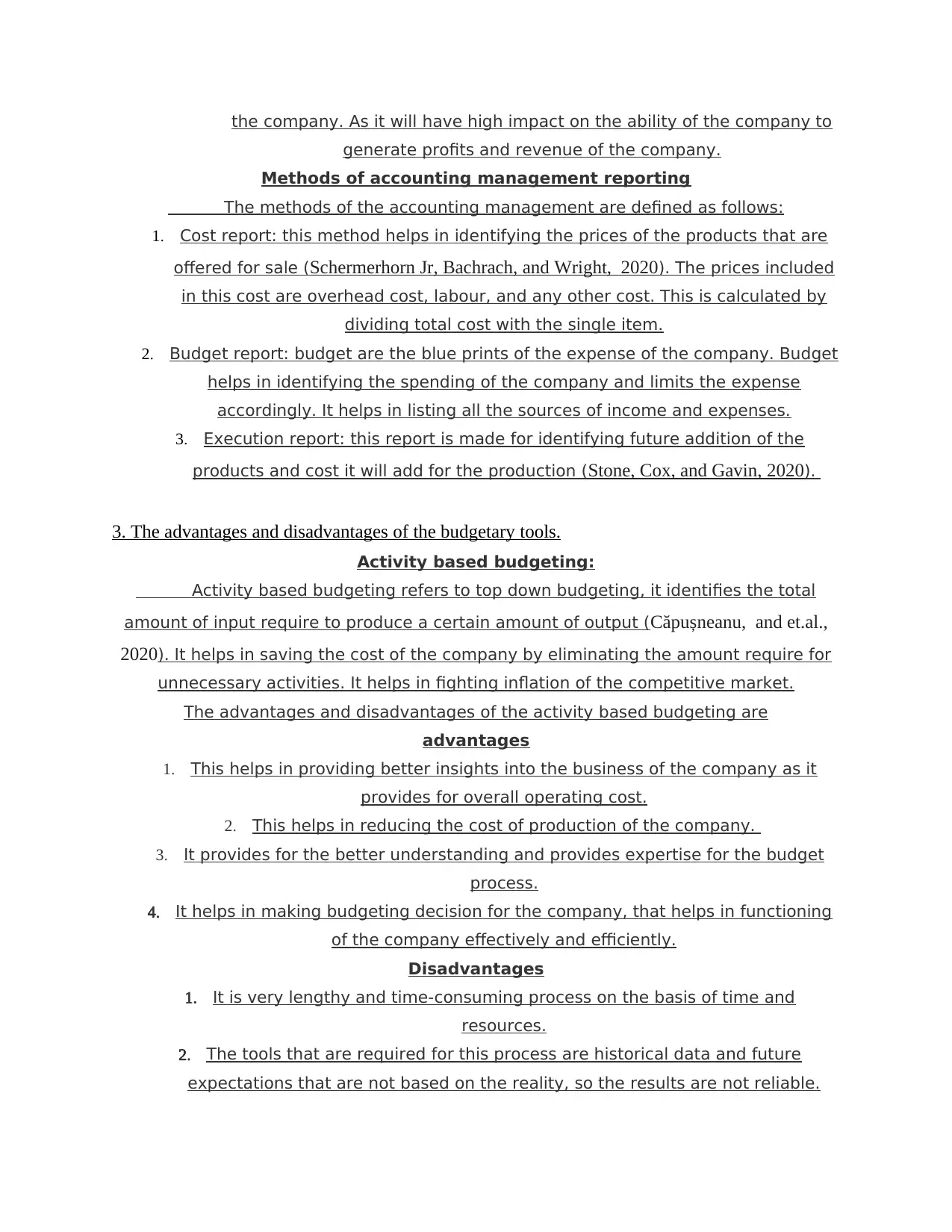
the company. As it will have high impact on the ability of the company to
generate profits and revenue of the company.
Methods of accounting management reporting
The methods of the accounting management are defined as follows:
1. Cost report: this method helps in identifying the prices of the products that are
offered for sale (Schermerhorn Jr, Bachrach, and Wright, 2020). The prices included
in this cost are overhead cost, labour, and any other cost. This is calculated by
dividing total cost with the single item.
2. Budget report: budget are the blue prints of the expense of the company. Budget
helps in identifying the spending of the company and limits the expense
accordingly. It helps in listing all the sources of income and expenses.
3. Execution report: this report is made for identifying future addition of the
products and cost it will add for the production (Stone, Cox, and Gavin, 2020).
3. The advantages and disadvantages of the budgetary tools.
Activity based budgeting:
Activity based budgeting refers to top down budgeting, it identifies the total
amount of input require to produce a certain amount of output (Căpușneanu, and et.al.,
2020). It helps in saving the cost of the company by eliminating the amount require for
unnecessary activities. It helps in fighting inflation of the competitive market.
The advantages and disadvantages of the activity based budgeting are
advantages
1. This helps in providing better insights into the business of the company as it
provides for overall operating cost.
2. This helps in reducing the cost of production of the company.
3. It provides for the better understanding and provides expertise for the budget
process.
4. It helps in making budgeting decision for the company, that helps in functioning
of the company effectively and efficiently.
Disadvantages
1. It is very lengthy and time-consuming process on the basis of time and
resources.
2. The tools that are required for this process are historical data and future
expectations that are not based on the reality, so the results are not reliable.
generate profits and revenue of the company.
Methods of accounting management reporting
The methods of the accounting management are defined as follows:
1. Cost report: this method helps in identifying the prices of the products that are
offered for sale (Schermerhorn Jr, Bachrach, and Wright, 2020). The prices included
in this cost are overhead cost, labour, and any other cost. This is calculated by
dividing total cost with the single item.
2. Budget report: budget are the blue prints of the expense of the company. Budget
helps in identifying the spending of the company and limits the expense
accordingly. It helps in listing all the sources of income and expenses.
3. Execution report: this report is made for identifying future addition of the
products and cost it will add for the production (Stone, Cox, and Gavin, 2020).
3. The advantages and disadvantages of the budgetary tools.
Activity based budgeting:
Activity based budgeting refers to top down budgeting, it identifies the total
amount of input require to produce a certain amount of output (Căpușneanu, and et.al.,
2020). It helps in saving the cost of the company by eliminating the amount require for
unnecessary activities. It helps in fighting inflation of the competitive market.
The advantages and disadvantages of the activity based budgeting are
advantages
1. This helps in providing better insights into the business of the company as it
provides for overall operating cost.
2. This helps in reducing the cost of production of the company.
3. It provides for the better understanding and provides expertise for the budget
process.
4. It helps in making budgeting decision for the company, that helps in functioning
of the company effectively and efficiently.
Disadvantages
1. It is very lengthy and time-consuming process on the basis of time and
resources.
2. The tools that are required for this process are historical data and future
expectations that are not based on the reality, so the results are not reliable.
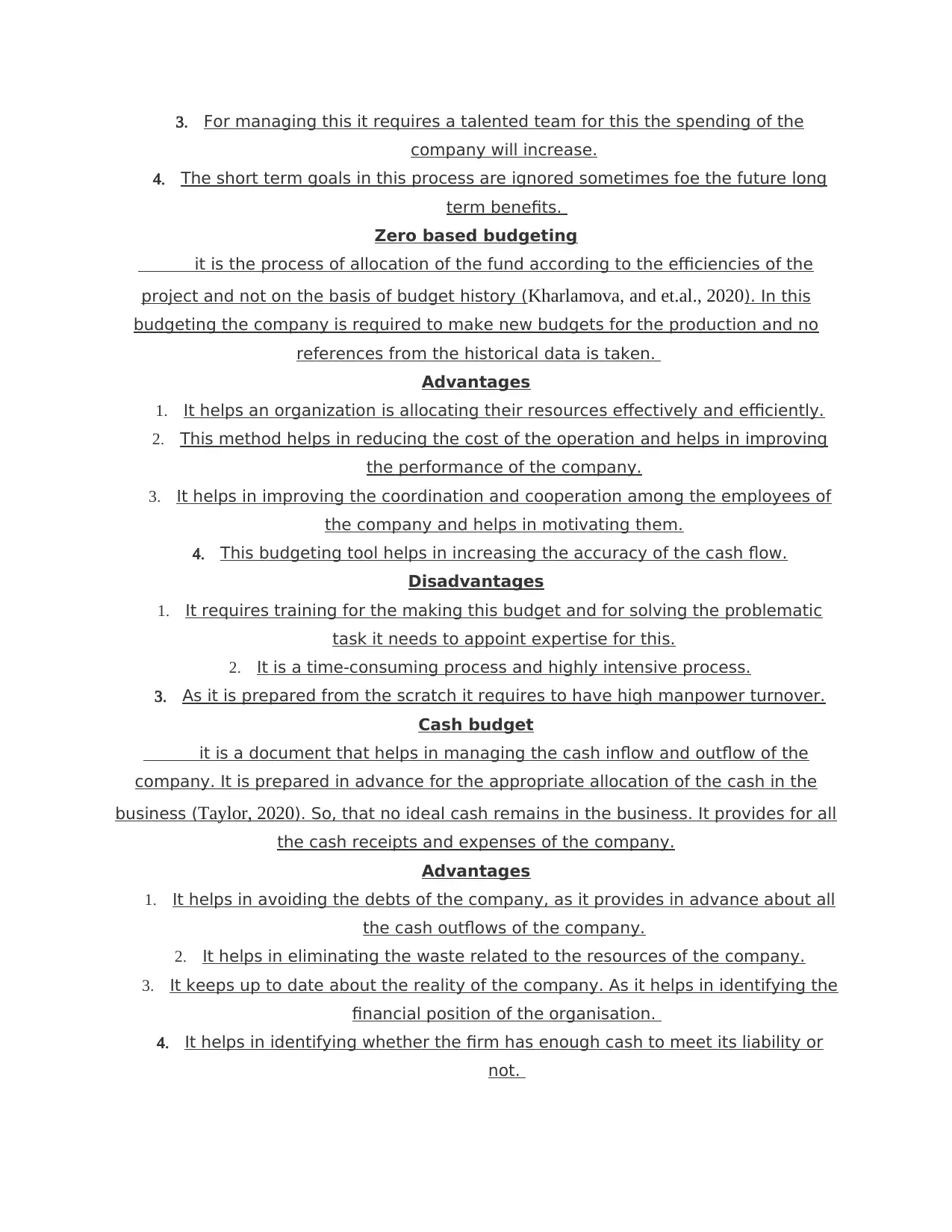
3. For managing this it requires a talented team for this the spending of the
company will increase.
4. The short term goals in this process are ignored sometimes foe the future long
term benefits.
Zero based budgeting
it is the process of allocation of the fund according to the efficiencies of the
project and not on the basis of budget history (Kharlamova, and et.al., 2020). In this
budgeting the company is required to make new budgets for the production and no
references from the historical data is taken.
Advantages
1. It helps an organization is allocating their resources effectively and efficiently.
2. This method helps in reducing the cost of the operation and helps in improving
the performance of the company.
3. It helps in improving the coordination and cooperation among the employees of
the company and helps in motivating them.
4. This budgeting tool helps in increasing the accuracy of the cash flow.
Disadvantages
1. It requires training for the making this budget and for solving the problematic
task it needs to appoint expertise for this.
2. It is a time-consuming process and highly intensive process.
3. As it is prepared from the scratch it requires to have high manpower turnover.
Cash budget
it is a document that helps in managing the cash inflow and outflow of the
company. It is prepared in advance for the appropriate allocation of the cash in the
business (Taylor, 2020). So, that no ideal cash remains in the business. It provides for all
the cash receipts and expenses of the company.
Advantages
1. It helps in avoiding the debts of the company, as it provides in advance about all
the cash outflows of the company.
2. It helps in eliminating the waste related to the resources of the company.
3. It keeps up to date about the reality of the company. As it helps in identifying the
financial position of the organisation.
4. It helps in identifying whether the firm has enough cash to meet its liability or
not.
company will increase.
4. The short term goals in this process are ignored sometimes foe the future long
term benefits.
Zero based budgeting
it is the process of allocation of the fund according to the efficiencies of the
project and not on the basis of budget history (Kharlamova, and et.al., 2020). In this
budgeting the company is required to make new budgets for the production and no
references from the historical data is taken.
Advantages
1. It helps an organization is allocating their resources effectively and efficiently.
2. This method helps in reducing the cost of the operation and helps in improving
the performance of the company.
3. It helps in improving the coordination and cooperation among the employees of
the company and helps in motivating them.
4. This budgeting tool helps in increasing the accuracy of the cash flow.
Disadvantages
1. It requires training for the making this budget and for solving the problematic
task it needs to appoint expertise for this.
2. It is a time-consuming process and highly intensive process.
3. As it is prepared from the scratch it requires to have high manpower turnover.
Cash budget
it is a document that helps in managing the cash inflow and outflow of the
company. It is prepared in advance for the appropriate allocation of the cash in the
business (Taylor, 2020). So, that no ideal cash remains in the business. It provides for all
the cash receipts and expenses of the company.
Advantages
1. It helps in avoiding the debts of the company, as it provides in advance about all
the cash outflows of the company.
2. It helps in eliminating the waste related to the resources of the company.
3. It keeps up to date about the reality of the company. As it helps in identifying the
financial position of the organisation.
4. It helps in identifying whether the firm has enough cash to meet its liability or
not.
⊘ This is a preview!⊘
Do you want full access?
Subscribe today to unlock all pages.

Trusted by 1+ million students worldwide
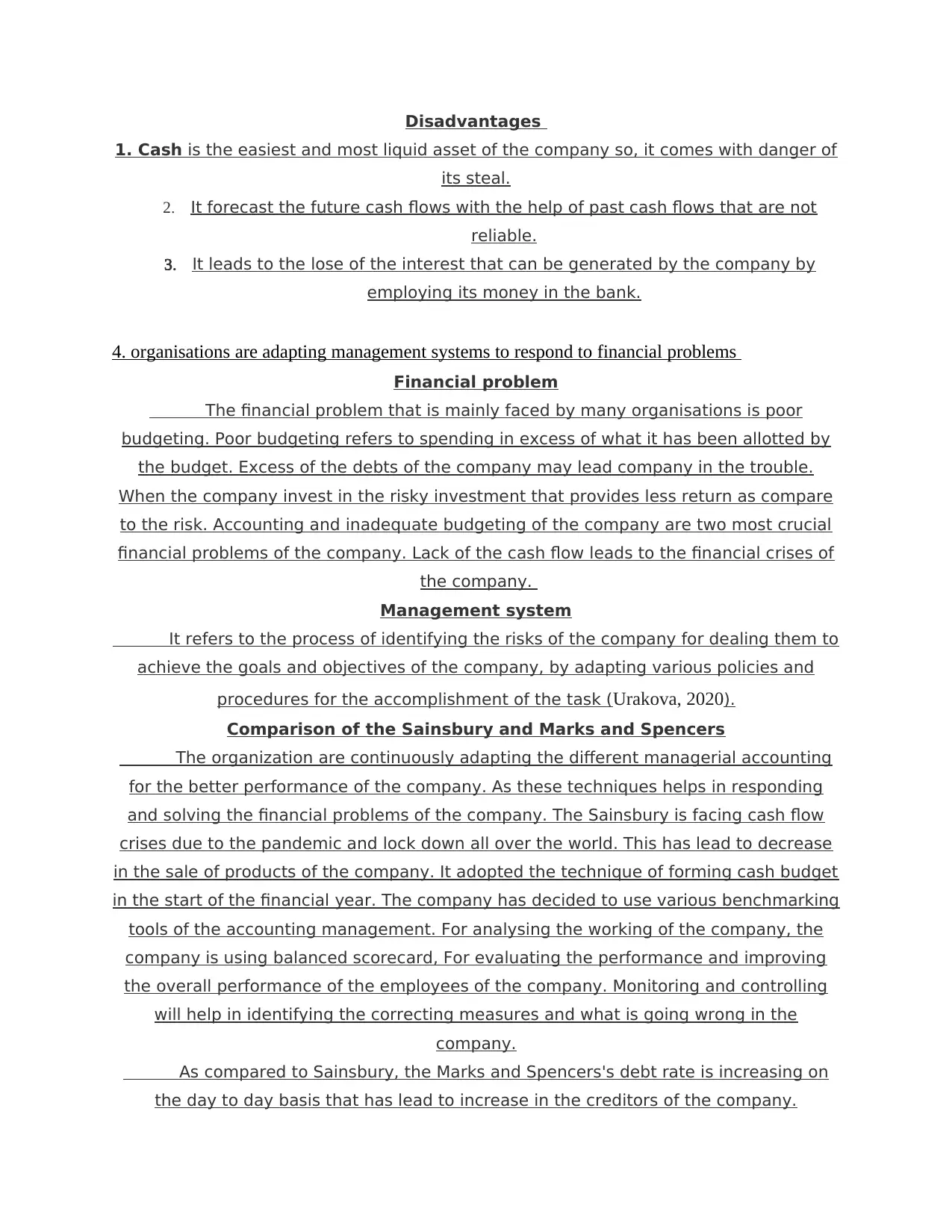
Disadvantages
1. Cash is the easiest and most liquid asset of the company so, it comes with danger of
its steal.
2. It forecast the future cash flows with the help of past cash flows that are not
reliable.
3. It leads to the lose of the interest that can be generated by the company by
employing its money in the bank.
4. organisations are adapting management systems to respond to financial problems
Financial problem
The financial problem that is mainly faced by many organisations is poor
budgeting. Poor budgeting refers to spending in excess of what it has been allotted by
the budget. Excess of the debts of the company may lead company in the trouble.
When the company invest in the risky investment that provides less return as compare
to the risk. Accounting and inadequate budgeting of the company are two most crucial
financial problems of the company. Lack of the cash flow leads to the financial crises of
the company.
Management system
It refers to the process of identifying the risks of the company for dealing them to
achieve the goals and objectives of the company, by adapting various policies and
procedures for the accomplishment of the task (Urakova, 2020).
Comparison of the Sainsbury and Marks and Spencers
The organization are continuously adapting the different managerial accounting
for the better performance of the company. As these techniques helps in responding
and solving the financial problems of the company. The Sainsbury is facing cash flow
crises due to the pandemic and lock down all over the world. This has lead to decrease
in the sale of products of the company. It adopted the technique of forming cash budget
in the start of the financial year. The company has decided to use various benchmarking
tools of the accounting management. For analysing the working of the company, the
company is using balanced scorecard, For evaluating the performance and improving
the overall performance of the employees of the company. Monitoring and controlling
will help in identifying the correcting measures and what is going wrong in the
company.
As compared to Sainsbury, the Marks and Spencers's debt rate is increasing on
the day to day basis that has lead to increase in the creditors of the company.
1. Cash is the easiest and most liquid asset of the company so, it comes with danger of
its steal.
2. It forecast the future cash flows with the help of past cash flows that are not
reliable.
3. It leads to the lose of the interest that can be generated by the company by
employing its money in the bank.
4. organisations are adapting management systems to respond to financial problems
Financial problem
The financial problem that is mainly faced by many organisations is poor
budgeting. Poor budgeting refers to spending in excess of what it has been allotted by
the budget. Excess of the debts of the company may lead company in the trouble.
When the company invest in the risky investment that provides less return as compare
to the risk. Accounting and inadequate budgeting of the company are two most crucial
financial problems of the company. Lack of the cash flow leads to the financial crises of
the company.
Management system
It refers to the process of identifying the risks of the company for dealing them to
achieve the goals and objectives of the company, by adapting various policies and
procedures for the accomplishment of the task (Urakova, 2020).
Comparison of the Sainsbury and Marks and Spencers
The organization are continuously adapting the different managerial accounting
for the better performance of the company. As these techniques helps in responding
and solving the financial problems of the company. The Sainsbury is facing cash flow
crises due to the pandemic and lock down all over the world. This has lead to decrease
in the sale of products of the company. It adopted the technique of forming cash budget
in the start of the financial year. The company has decided to use various benchmarking
tools of the accounting management. For analysing the working of the company, the
company is using balanced scorecard, For evaluating the performance and improving
the overall performance of the employees of the company. Monitoring and controlling
will help in identifying the correcting measures and what is going wrong in the
company.
As compared to Sainsbury, the Marks and Spencers's debt rate is increasing on
the day to day basis that has lead to increase in the creditors of the company.
Paraphrase This Document
Need a fresh take? Get an instant paraphrase of this document with our AI Paraphraser
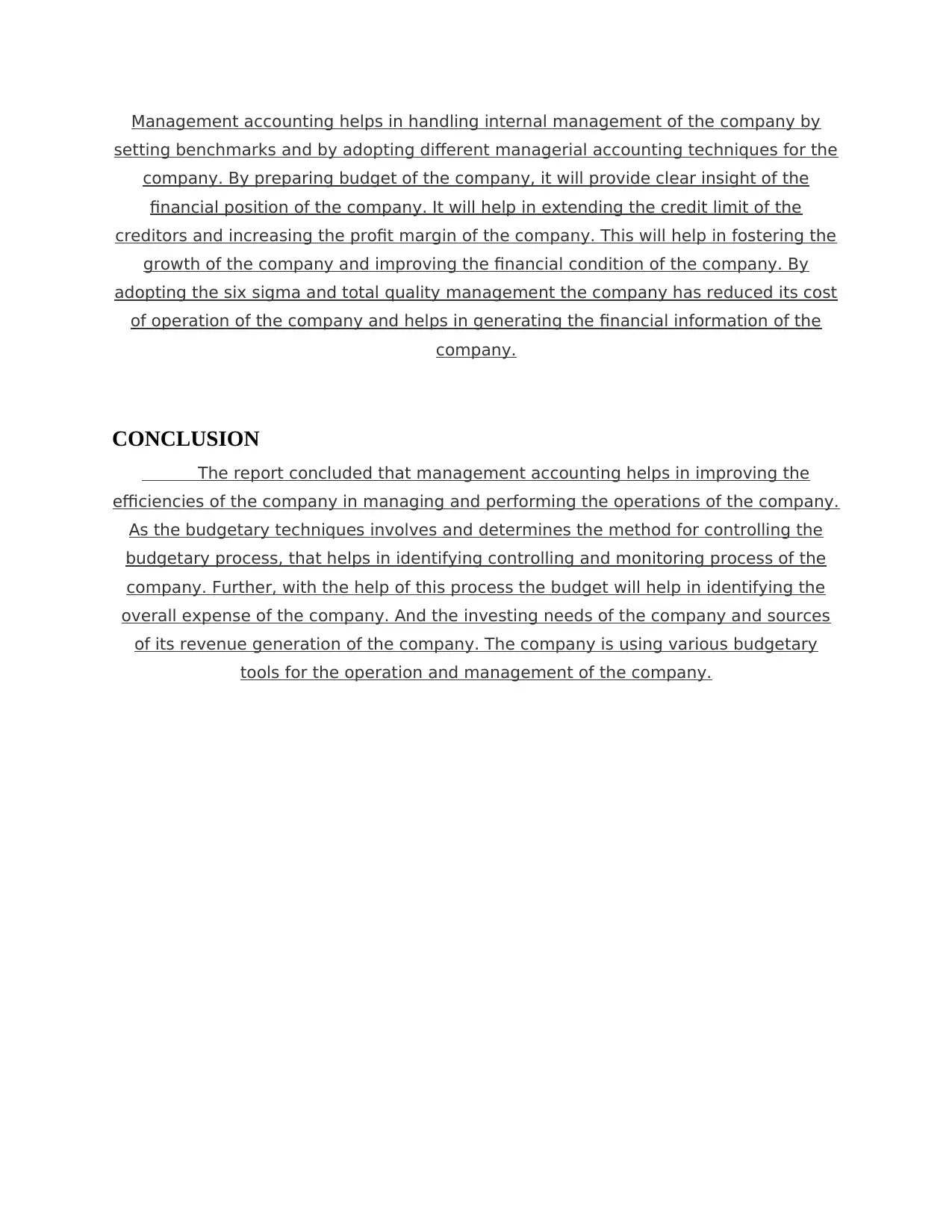
Management accounting helps in handling internal management of the company by
setting benchmarks and by adopting different managerial accounting techniques for the
company. By preparing budget of the company, it will provide clear insight of the
financial position of the company. It will help in extending the credit limit of the
creditors and increasing the profit margin of the company. This will help in fostering the
growth of the company and improving the financial condition of the company. By
adopting the six sigma and total quality management the company has reduced its cost
of operation of the company and helps in generating the financial information of the
company.
CONCLUSION
The report concluded that management accounting helps in improving the
efficiencies of the company in managing and performing the operations of the company.
As the budgetary techniques involves and determines the method for controlling the
budgetary process, that helps in identifying controlling and monitoring process of the
company. Further, with the help of this process the budget will help in identifying the
overall expense of the company. And the investing needs of the company and sources
of its revenue generation of the company. The company is using various budgetary
tools for the operation and management of the company.
setting benchmarks and by adopting different managerial accounting techniques for the
company. By preparing budget of the company, it will provide clear insight of the
financial position of the company. It will help in extending the credit limit of the
creditors and increasing the profit margin of the company. This will help in fostering the
growth of the company and improving the financial condition of the company. By
adopting the six sigma and total quality management the company has reduced its cost
of operation of the company and helps in generating the financial information of the
company.
CONCLUSION
The report concluded that management accounting helps in improving the
efficiencies of the company in managing and performing the operations of the company.
As the budgetary techniques involves and determines the method for controlling the
budgetary process, that helps in identifying controlling and monitoring process of the
company. Further, with the help of this process the budget will help in identifying the
overall expense of the company. And the investing needs of the company and sources
of its revenue generation of the company. The company is using various budgetary
tools for the operation and management of the company.
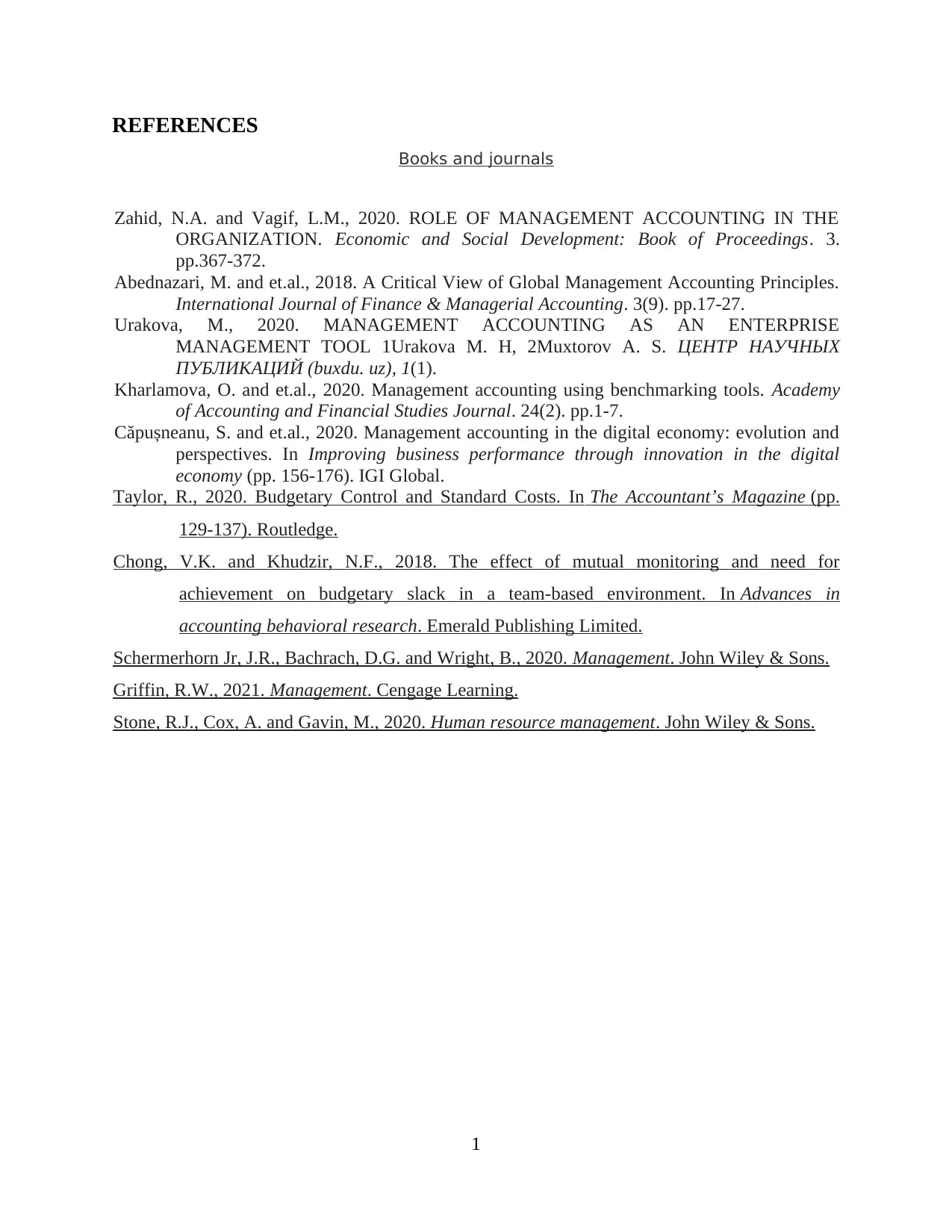
REFERENCES
Books and journals
Zahid, N.A. and Vagif, L.M., 2020. ROLE OF MANAGEMENT ACCOUNTING IN THE
ORGANIZATION. Economic and Social Development: Book of Proceedings. 3.
pp.367-372.
Abednazari, M. and et.al., 2018. A Critical View of Global Management Accounting Principles.
International Journal of Finance & Managerial Accounting. 3(9). pp.17-27.
Urakova, M., 2020. MANAGEMENT ACCOUNTING AS AN ENTERPRISE
MANAGEMENT TOOL 1Urakova M. H, 2Muxtorov A. S. ЦЕНТР НАУЧНЫХ
ПУБЛИКАЦИЙ (buxdu. uz), 1(1).
Kharlamova, O. and et.al., 2020. Management accounting using benchmarking tools. Academy
of Accounting and Financial Studies Journal. 24(2). pp.1-7.
Căpușneanu, S. and et.al., 2020. Management accounting in the digital economy: evolution and
perspectives. In Improving business performance through innovation in the digital
economy (pp. 156-176). IGI Global.
Taylor, R., 2020. Budgetary Control and Standard Costs. In The Accountant’s Magazine (pp.
129-137). Routledge.
Chong, V.K. and Khudzir, N.F., 2018. The effect of mutual monitoring and need for
achievement on budgetary slack in a team-based environment. In Advances in
accounting behavioral research. Emerald Publishing Limited.
Schermerhorn Jr, J.R., Bachrach, D.G. and Wright, B., 2020. Management. John Wiley & Sons.
Griffin, R.W., 2021. Management. Cengage Learning.
Stone, R.J., Cox, A. and Gavin, M., 2020. Human resource management. John Wiley & Sons.
1
Books and journals
Zahid, N.A. and Vagif, L.M., 2020. ROLE OF MANAGEMENT ACCOUNTING IN THE
ORGANIZATION. Economic and Social Development: Book of Proceedings. 3.
pp.367-372.
Abednazari, M. and et.al., 2018. A Critical View of Global Management Accounting Principles.
International Journal of Finance & Managerial Accounting. 3(9). pp.17-27.
Urakova, M., 2020. MANAGEMENT ACCOUNTING AS AN ENTERPRISE
MANAGEMENT TOOL 1Urakova M. H, 2Muxtorov A. S. ЦЕНТР НАУЧНЫХ
ПУБЛИКАЦИЙ (buxdu. uz), 1(1).
Kharlamova, O. and et.al., 2020. Management accounting using benchmarking tools. Academy
of Accounting and Financial Studies Journal. 24(2). pp.1-7.
Căpușneanu, S. and et.al., 2020. Management accounting in the digital economy: evolution and
perspectives. In Improving business performance through innovation in the digital
economy (pp. 156-176). IGI Global.
Taylor, R., 2020. Budgetary Control and Standard Costs. In The Accountant’s Magazine (pp.
129-137). Routledge.
Chong, V.K. and Khudzir, N.F., 2018. The effect of mutual monitoring and need for
achievement on budgetary slack in a team-based environment. In Advances in
accounting behavioral research. Emerald Publishing Limited.
Schermerhorn Jr, J.R., Bachrach, D.G. and Wright, B., 2020. Management. John Wiley & Sons.
Griffin, R.W., 2021. Management. Cengage Learning.
Stone, R.J., Cox, A. and Gavin, M., 2020. Human resource management. John Wiley & Sons.
1
⊘ This is a preview!⊘
Do you want full access?
Subscribe today to unlock all pages.

Trusted by 1+ million students worldwide
1 out of 9
Related Documents
Your All-in-One AI-Powered Toolkit for Academic Success.
+13062052269
info@desklib.com
Available 24*7 on WhatsApp / Email
![[object Object]](/_next/static/media/star-bottom.7253800d.svg)
Unlock your academic potential
Copyright © 2020–2025 A2Z Services. All Rights Reserved. Developed and managed by ZUCOL.




